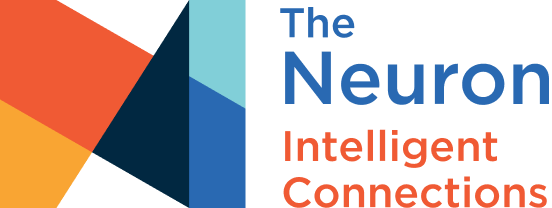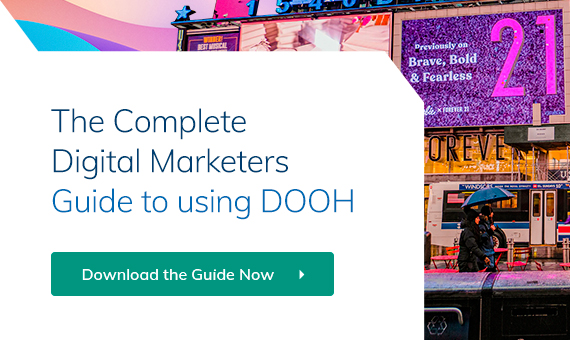Digital Out of Home advertising has been around for a good many years now, but it remains one of the most underrated forms of marketing. In comparison to online Google ads or ads placed on websites, DOOH advertising offers huge benefits that are often overlooked by marketers seeking an effective way to reach their target audience.
The Digital Out of Home Advertising Market
The digital Out of Home (DOOH) advertising market, a subset of the Out of-Home (OOH) ad market, is growing.
According to a recent Research and Markets report – Digital OOH: Global Market Trajectory & Analytics – the global digital OOH market is projected to hit US$35.1 Billion by 2027. The US accounts for roughly 30% of this market.
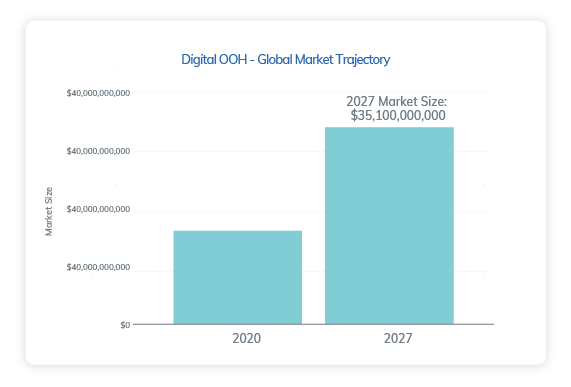
(Data source: researchandmarkets.com)
Below, we discuss six of the top benefits of using DOOH advertising vs online advertising so you can see precisely why you should be considering using digital signage in your marketing strategy right now.
1. Large Audience Reach
It may be tough to reach a significant number of people in today’s environment when readers and viewers of traditional media are declining, and audiences online are splintering. DOOH cuts through this fragmentation, ensuring messages get seen while people are out and engaged with their surroundings.
Indeed, there’s evidence that consumers are spending more time outdoors than they used to, giving outdoor ads greater exposure, while at the same time experiencing digital device burnout.
A 2021 report by the Out Of Home Advertising Association Of America (OAAA) and the Harris Poll reveals 75% of people stated that excessive time on devices is causing them to tune out of digital device ads – pointing to the strong potential for Out of Home advertising to take on greater potency to fill the void.
The report finds that consumers are more receptive to Out of Home messaging, especially in the larger urban areas.
Over half (55%) of consumers who live in big cities (1 million+ population) reported that they are noticing more OOH messaging and signage today, compared to 41% of the population as a whole. Crucially, over a third (34%) of big city dwellers say that OOH is influencing their purchase decisions.
In addition, the survey reveals that consumers notice OOH the most while driving – 83% on highways and 82% driving locally around their city or town. People are also noticing OOH and DOOH while walking around local downtown or “main street” areas (63%), when at the airport (51%), and while using public transport (46%).
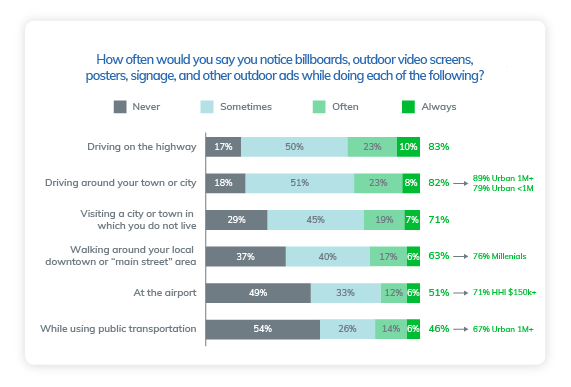
(Image source: oaaa.org)
2. Targeted Without Being Intrusive
Concern has been mounting among privacy advocacy organizations about how online advertising, search engines, and social networks use behavioral advertising to monitor consumers and build profiles based on their internet activities and apps.
For example, according to a recent Wall Street Journal investigation, popular health applications share highly personal information with social networking sites.
Consumers are worried about online data privacy as well – and that’s eroding consumer trust.
According to a KPMG poll of 2,000 Americans and 250 business executives, 70% of firms have increased their collection of personal consumer information over the last year. The same poll also found that 86% of Americans have a growing concern over data privacy.
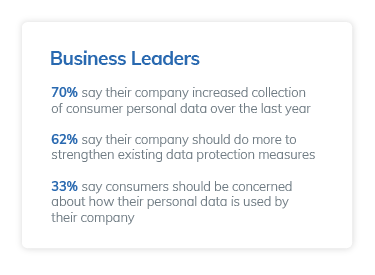
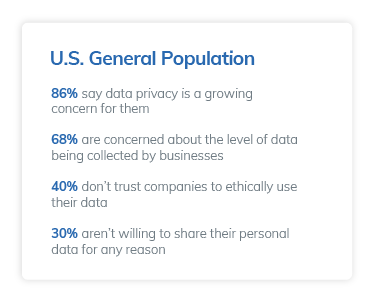
(Image source: kpmg.us)
DOOH audience data tracking is completely different to online tracking – meaning that data privacy concerns are greatly reduced, if not entirely eliminated. With digital Out of Home, rather than gathering and storing highly sensitive personal data about individual consumers, ad targeting is conducted via anonymous mobile location data to understand where certain demographics spend their time, together with their daily routines near to digital screens. Impressions are gathered using GDPR compliance methods that do not infringe upon the privacy of audiences.
Over time, a complete yet fully anonymized picture of target audience movement emerges. This makes it possible to discover patterns of consumer behavior – however, no unique identifiers are ever collected.
This means that DOOH is great for targeting campaigns to appropriate audiences rather than specific individuals.
3. Online Ad Blocking Is Pervasive
Remarketing – the cookie-based online advertising practice where online ads follow consumers everywhere they go online – is intrusive and often leads to ad fatigue. Consumers have responded by installing ad blockers on a massive scale, especially on mobile devices.
According to the 2021 PageFair Adblock Report from ad tech firm Blockthrough, the number of mobile devices using ad blocking doubled from 282 million to 586 million between 2015 and 2020.
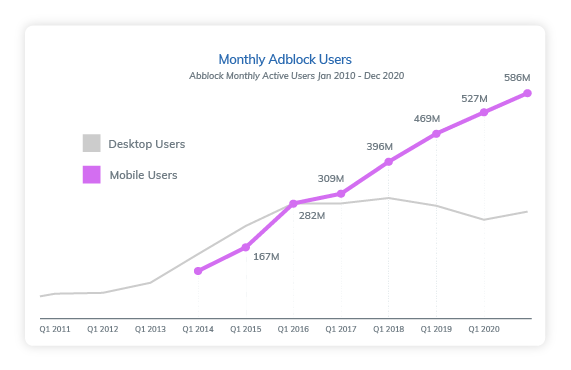
(Image source: cnet.com)
Fortunately, viewers cannot block DOOH ads. Digital out-of-home signage is impervious to ad blocking, ensuring that your advertisements reach the right audiences at all times.
4. DOOH Is Easy to Purchase with Programmatic Technology
Digital OOH can be purchased and managed efficiently through programmatic DOOH (pDOOH) platforms. Put simply, pDOOH is the automated buying and delivery of DOOH advertising on digital billboards and other signage.
Using a specialized programmatic platform, advertisers set specific conditions (i.e., how, when, where, and to whom they want their ads to appear) for how they want to buy media, and when those conditions are met, ad space is purchased, and the ad delivered automatically.
With a few clicks, marketers can plan their campaigns based on budget allocation or location-based targeting criteria across multiple screens in one go. This automation allows for accurate campaign management without manual intervention by sales teams or external agencies, saving both time and money.
Read more: How Does Programmatic OOH Work?
This ease of purchase also opens up digital out-of-home networks to smaller businesses that would not usually have the resources to purchase digital out-of-home media.
5. Reach People When Ready to Engage – Including at Point of Sale
In addition to roadside billboards, DOOH signage is placed in locations where people are necessarily having to spend time or wanting to relax – such as airports, metro stations, sports stadia, and shopping malls – and also when their intent to buy is higher than when they’re online doing other things, such as working, browsing social media, or chatting to friends. Dwell time is high in these areas, providing a captive audience for your ads.
The ability of DOOH to engage consumers when desire is strong, capture attention, build relationships, and drive purchases in-store sets it apart from other marketing channels. As such, DOOH can be extremely effective right up and down the sales and marketing funnel – impacting not only brand awareness, but consideration and ultimately in-store sales revenue.
DOOH advertising is great for reaching consumers right before making a purchase decision. This aspect allows marketers to engage with customers precisely at the moment that matters the most to the purchaser.
6. DOOH Is More Connected and Engaged
DOOH digital signage advertising has the power to engage consumers in ways that online digital advertisements cannot.
DOOH advertisements can be interactive. Customers can, for example, interact with an ad using their smartphones. Marketers may use this to encourage entries into a contest in exchange for consumer information, give discounts to boost sales, or even provide free content.
Also, when combined with online ads, DOOH and OOH ads have high engagement rates. For example, mobile click-through rates increase by 15% when supported by OOH ads, and roughly half of US consumers use a search engine after seeing an OOH ad, according to figures cited by Carto.
Get Started with Digital Out of Home Advertising
Digital OOH advertising, particularly when bought programmatically, leads to successful marketing campaigns. But, to make the most of it, you need a programmatic DOOH platform that connects you seamlessly with the marketing assets you need.
At The Neuron, we provide ad buyers with a platform that offers automated bidding and eliminates all the middlemen from the process. As a result, you can upload and optimize your campaign in just a few simple steps, giving you complete flexibility and control over your DOOH ad campaigns.
